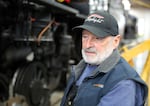
Bill Habjan, a retired doctor from Lebanon, makes the 160-mile round trip to the Oregon Rail Heritage Center in Portland’s Central Eastside twice a week to work on an old engine. “When a steam locomotive is fired up, it’s the closest thing to a living machine you’re going to ever see,” he said. Photographed on Feb. 28, 2024.
Kristian Foden-Vencil / OPB
Bill Habjan, a retired doctor from Lebanon, Oregon, makes the 160-mile round trip to the Oregon Rail Heritage Center in Portland’s Central Eastside twice a week to work on an old engine.
“When a steam locomotive is fired up, it’s the closest thing to a living machine you’re going to ever see,” he said. “You hear the heartbeat of them. It’s just kind of a machine saying: ‘Let’s go, we’ve got stuff to do.’”
The Oregon Rail Heritage Center opened 12 years ago, primarily as a place for rail enthusiasts such as Habjan to fix steam engines. Habjan grew up in the 1950s when much of his family worked for the New York Central Railroad. He remembers his uncle overlooking the steam yard and explaining to him that diesel was the fuel of the future.
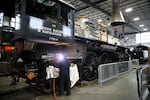
Volunteers work on an Oregon Railroad & Navigation Co. locomotive on Feb. 28, 2024.
Kristian Foden-Vencil / OPB
“He said to me: ‘See those things? They’re going away!’”
Habjan has done his best to keep steam alive since then. But he’s 78 now. “And arthritis is kicking in,” he said.
Across the country, the nation’s some 200-plus railway groups are experiencing a similar generational shift in audience.
“We had the same issue,” said Jacqueline Frank, CEO of the National Railroad Museum in Green Bay, Wisconsin.
While the museum has plenty of older volunteers like Habjan, she noticed that two-thirds of visitors were actually parents with young children, looking for something fun to do during the day.
So the museum operators decided to shift their focus, from locomotive maintenance to education. Attendance doubled.
“I’m seeing more and more railroad museums trying to professionalize themselves and become more of a museum that happens to have that railroad theme,” Frank said. “As opposed to a couple of guys and the train they’re working on.”
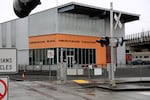
The Oregon Rail Heritage Center in Portland, Feb. 28, 2024.
Kristian Foden-Vencil / OPB
But walking into the Oregon Rail Heritage Center is, for now, nothing like walking into a museum. The sparks of an arc welder often speckle the background or a pneumatic rust remover rattles away.
Rather than a foyer with a ticket booth, you’re immediately immersed in a workshop with three enormous locomotives in various states of repair. Men in work clothes clamber over each one, boring piston cylinders or welding fire boxes.
“It’s very gritty and nasty,” said Renee Devereux, the executive director of the rail center. “It’s also been sort of a closed community. It’s a hard group to sort of break into, which is changing.”
Devereux said the old silos are opening up, and new volunteers are more than welcome; the workshop just took ownership of a 100-year-old logging locomotive, the Mount Emily Shay #1, from Prineville, that needs maintenance.
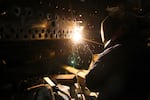
Welding at the Oregon Rail Heritage Center, Feb. 28 2024.
Kristian Foden-Vencil / OPB
But she said, more than attracting new volunteers, the rail center wants more visitors.
“I feel like we’re one of the biggest buildings in town that nobody sees,” Devereux said.
The Oregon Rail Heritage Center gets about 60,000 visitors a year, if all the passengers taking special rail trips to Oaks Park are included in that count. Attendance pales in comparison to the Oregon Museum of Science and Industry, which sits a few hundred yards away and boasts more than a million visitors a year.
So now, the rail center is trying to morph into a museum.
“When I first started in 2018 the word museum was rarely heard around here,” said Roger Woehl, the rail center’s vice president. “Today, it’s commonly referred to as a museum.”
He said center organizers have plans to become more like a museum.
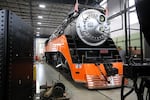
The Southern Pacific 4449 is considered one of the best operable “streamlined” steam locomotives of the Art Deco era. It pulled Southern Pacific “Daylight” coaches from Los Angeles to San Francisco over the scenic Coast Route to Portland until 1955.
Kristian Foden-Vencil / OPB
First, they’re going to put up banners advertising their hours, the free admission, and the free parking that nobody seems to know about because it’s hidden under an overpass.
Then they’re going to decorate the front entrance with railway memorabilia like signal posts, a station master’s clock and an old railway canopy.
They’ve already installed a vintage train turntable and taken charge of a new steam engine.
Woehl said there’s also talk of charging for admission; adding new exhibits; hiring an activities coordinator to generate buzz; holding story times and more educational programs for kids; and maybe even adding new space to host events.
But all that costs money.

A locomotive cross-section diagram on display at the Oregon Heritage Rail.
Kristian Foden-Vencil / OPB
“It’s a young museum, it’s grown up thinking frugally,” Woehl said. “It’s a nonprofit. Nonprofits have to think frugally.”
Frugality has served the rail center well, especially during the pandemic when everything shut down.
The dream for Oregon rail lovers is the California State Railroad Museum in Sacramento. It gets state support so has sufficient staff and exhibits, like the golden spike that completed the nation’s first transcontinental railroad.
But that kind of state assistance isn’t being discussed at the Oregon Rail Heritage Center. Instead, the museum plans to rely on its massive engines, which take three days to heat up.
Meanwhile, the people who run Oregon Rail Heritage Center want everyone to know that a visit is a fun and comparatively cheap day out.
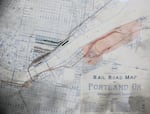
An old rail map on display at the Oregon Rail Heritage Center.
Kristian Foden-Vencil / OPB
